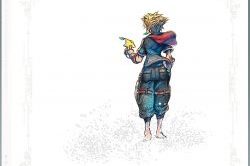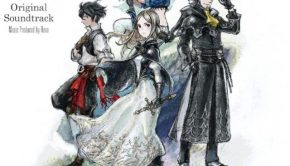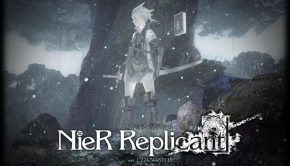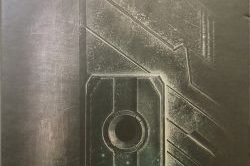Bravely Second -End Layer- Original Soundtrack
 |
Album Title: Bravely Second -End Layer- Original Soundtrack |
| Record Label: Square Enix |
|
| Catalog No.: SQEX-10497/9 (Regular Edition); SQEX-10494/6 (Limited Edition) |
|
| Release Date: May 20, 2015 |
|
| Purchase: Buy at CDJapan |
Overview
The Bravely Default series was Square Enix’s answer to consumers who were itching for a “return to roots” RPG in the vein of classic Final Fantasy. The first game saw the Japanese fantasy band Sound Horizon’s lead founder and composer “Revo” on music. To many, this decision to hire a mainstream artist to write music for the game was received very well. However, due to time constraints, Revo was not able to return for the sequel. Square Enix brought in another mainstream artist “ryo” from Supercell. ryo’s style is much different from Revo, as his music leans more toward a J-pop sound and shies away from the fantasy rock feel Revo solidified in the original game. Can a J-pop artist live up to the incredible world Revo was able to create in the world of Luxendarc?
Body
The album opens with the main theme of Bravely Second. The track sticks to the formula of orchestra and piano, with a really nice inclusion of the main theme melody from Bravely Default on piano before it repeats. The character themes hold to this style as well, although each one adds it’s own unique flair. “Theme of Yu” goes for a more upbeat regal sound, while “Theme of the Emperor Oblivion” focuses on a sinister motif, building in intensity while giving off a heightened sense of fear. Magnolia’s theme is much slower. I feel like her theme, while peaceful, has a very sad underscore to the melody. This one is easily one of my favorites on the soundtrack.
The area themes are very hit and miss. “Orthodox Capital Gateratio” doesn’t seem to fit anywhere within the scope of the world of Luxendarc at all. The melody starts off bouncy and fun, but the harmony in the later sections feels off key and ruins the light heartedness of the piece. The music in the city of Istantal, however, is quite a bit better and reminds me of the music in Alexandria in Final Fantasy IX. It retains the bouncy feel, but doesn’t degrade the melody later on. The piano melody at 1:07 is quite a beautiful direction and I find myself coming back to this track often just for that section! The final two town themes for the locations of Sagitta and Yunohama both make use to traditional Japanese instrumentation and are quite beautiful. This is especially true at 1:44 in the theme in Sagitta. The piano really enhances the harmony here and I quite like it.
Continuing on the location themes, the music for the game’s dungeons also stand up great on their own merits as well. The music for the first dungeon has a wonderful wind melody that climaxes with a fluttering flute effect. The music that plays in tower-based dungeons is much bouncer and intense. It reminds me of a tower dungeon theme you’d hear in a Dragon Quest game (you’ll actually find this to be a common comparison throughout the album). The music in caves also builds on the Dragon Quest tradition of RPG scoring. Beginning with an ascending wind melody and a haunting string harmony, the theme evolves into a sinister feel with loud blasts of the string melody followed up by silence. The final dungeon theme “Road leading to God” is one of the most epic pieces on the soundtrack. This one gives me heavy vibes of the final dungeon theme from Tales of Innocence, until the choir is added in to give it a more peaceful tone. The melody quickly picks up from there with a marching percussion and a return of the choir, but this time sounding much more evil. A must listen for anyone giving this album a try!
To close off the discussion of area themes, let’s talk about the music that plays on the world map. The standard overworld theme takes a similar approach to Bravely Default, as it’s split into a day/night cycle. While the day section is bouncy and again takes a card from the Dragon Quest overworlds, the nighttime sections pulls it back and focuses on piano and pizzicato strings. The climax of both sections revisits the main theme of the game with a bombast orchestra closing the song an an epic note. While I have heard overworld themes that stand better outside of the game, this one couldn’t be more perfect driving home the large-scale exploration aspect of old school RPG overworld themes and really fits the world of Luxendarc well.
Once you receive a ship, you’ll get to hear what I consider to be one of my favorite “sailing” themes in an RPG. Once again ryo revisits the bouncy style of the Dragon Quest series, although improving the formula with a really nice string climax. When you get the upgraded ship, the music changes to an arrangement of the same piece, but oh boy is this version fantastic. The focus here shifts away from the bouncy orchestral sound to a flamenco guitar harmony and accordion melody. Close your eyes and imagine riding through the venetian canals on a gondola and this music will just naturally come to you. This is what I would deem a “perfect” theme for riding on a ship! Lastly, we have “Flying Ship”. I have mixed feelings about this one. I don’t get the feeling of flying at all from the melody in this one, but the section at 0:39 is so beautiful and epic it almost makes up for it. I’ve attempted to take this on without comparing the music to Revo’s soundtrack for Bravely Default. However, after the incredible “Ship Soaring Through the Heavens” from the original game, “Flying Ship” just sounds bland and emotionless.
That said, I feel ryo easily destroys Revo in the battle theme front. The normal battle theme begins with an introduction that closely resembles the intro to Final Fantasy VII‘s battle theme. The similarities end there though, and the song quickly takes over with screaming guitar shredding and an epic synth choir. The boss theme, oh lord the boss theme, is another highlight. What starts with a grungy bass guitar, stomping percussion and chanting choir, quickly morphs into a heavy metal piece that doesn’t lose ground by adding in epic choir and strings that really give the song a level of individuality not heard in recent years. The screaming guitar, choir, epic undertones of orchestral work, and incredible variety in the sections make this to be one of my favorite RPG boss themes of all time. The only complaint I have here is the battle themes are almost too intense for their respective battle types.
Moving onto my personal favorite part of the soundtrack, the final boss themes. The first of the three takes the screaming guitar approach of the other battle themes, but stands out from there with a lead melody that focus on flamenco acoustic guitar work and a punchy keyboard solo. The second final boss theme is an arrangement of the first, but intensifies it with the flamenco guitar being replaced with the electric guitar. The timing of the piece has slowed down, giving it a bit more of an epic feel. This all culminates at 1:00, where everything drops out and an electronic screech carries us into a speed metal section led with a live sampled choir. Considering the rest of the album featured synth choir this was an incredible surprise.
This one deserves it’s own paragraph, maybe even it’s own full review. “Battle of Providence,” the final piece of the final battle trio, is one of the greatest things I’ve ever heard in my life. The song begins with something I’ve dubbed the “choir falling off a cliff” effect, an organ buildup, and a spooky electronic section. It builds into an amazing speed metal section featuring that same choir again, which takes the limelight at the 1:37 mark. After that incredible speed metal section I was NOT expecting it to stop and give way for a heroic choir focus that is epic and punchy. This repeats again, but the epic choir part on the second loop retains the speed metal pace in the percussion. The song then transitions to a medley of the character special battle themes, which each have their own unique style to fit the characters perfectly. The heavy rock focus is mostly gone here, bringing a focus to the orchestral side of the character themes. The Bravely Second theme then makes a comeback and the nine minute epic closed with a rendition of Emperor Oblivion’s theme before repeating from the beginning. I used to think Revo’s final boss theme was one of the greatest final boss themes in RPG history, but somehow this replaced it. This is BEYOND incredible!
Summary
While Bravely Second‘s soundtrack has received a mixed reception so far, I personally feel it is still a stellar effort. I feel ryo did a really good job following up what was easily one of my favorite RPG soundtracks of all time. While some of the themes here are a little bland and don’t hold up well against the first game’s soundtrack, I feel like that can be forgiven based on the quality of the battle themes alone. Just be warned, ryo took this in an entirely different direction than Revo did, and if you are looking for anything similar to that you might be disappointed. What you will find here, among a few less than stellar tracks, is something a bit darker, heavier, and arguably with more variety. It’s not for everyone, but in my opinion, it is certainly worth a purchase!
Do you agree with the review and score? Let us know in the comments below!
4
Posted on May 23, 2015 by Bryan Matheny. Last modified on May 23, 2015.














